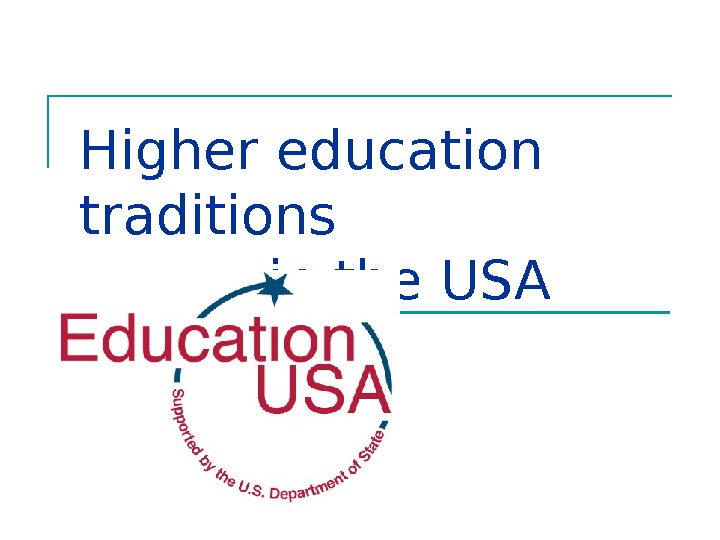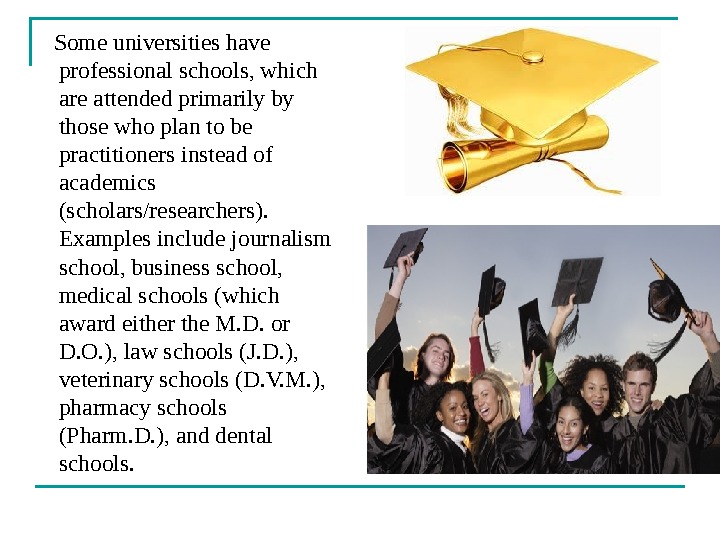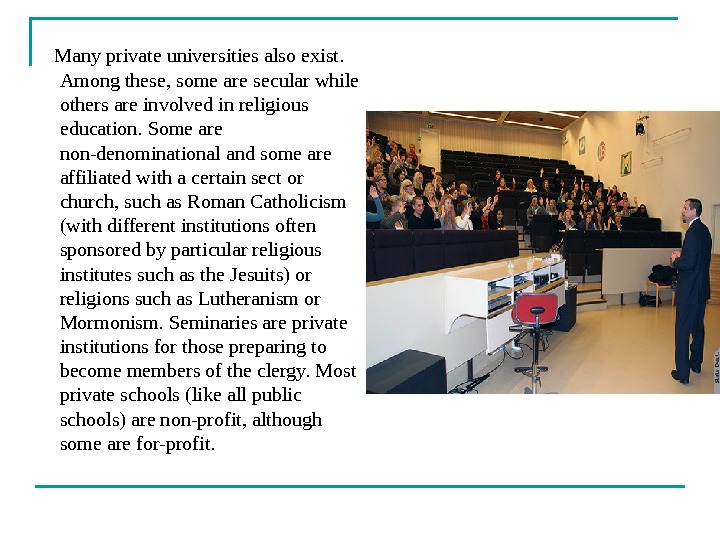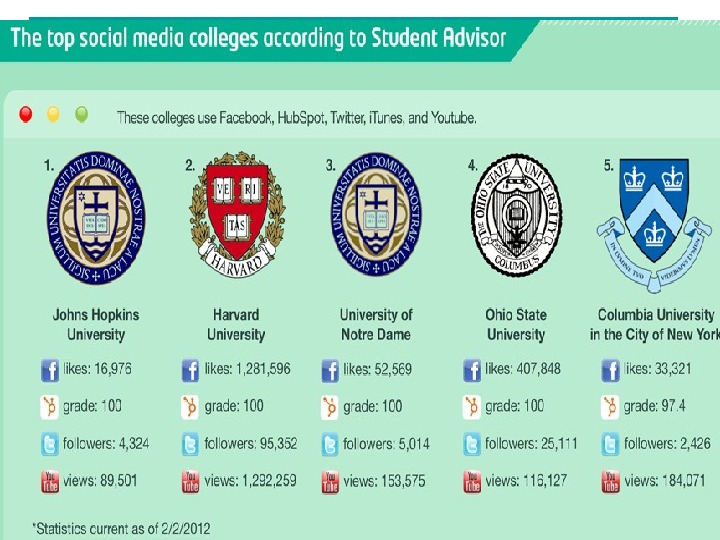Higher education traditions in the USA















- Размер: 2 Mегабайта
- Количество слайдов: 14
Описание презентации Higher education traditions in the USA по слайдам
 Higher education traditions in the US
Higher education traditions in the US
 Higher education in the United States includes a variety of institutions of higher education. Strong research and funding have helped make United States colleges and universities among the world’s most prestigious, making them particularly attractive to international students, professors and researchers in the pursuit of academic excellence. According to the Shanghai Jiao Tong University’s Academic Ranking of World Universities, more than 30 of the highest-ranked 45 institutions are in the United States. Public universities, private universities, liberal arts colleges, and community colleges all have a significant role in higher education in the United States.
Higher education in the United States includes a variety of institutions of higher education. Strong research and funding have helped make United States colleges and universities among the world’s most prestigious, making them particularly attractive to international students, professors and researchers in the pursuit of academic excellence. According to the Shanghai Jiao Tong University’s Academic Ranking of World Universities, more than 30 of the highest-ranked 45 institutions are in the United States. Public universities, private universities, liberal arts colleges, and community colleges all have a significant role in higher education in the United States.
 Colleges and universities in the U. S. vary in terms of goals: some may emphasize a vocational, business, engineering, or technical curriculum while others may emphasize a liberal arts curriculum. Many combine some or all of the above.
Colleges and universities in the U. S. vary in terms of goals: some may emphasize a vocational, business, engineering, or technical curriculum while others may emphasize a liberal arts curriculum. Many combine some or all of the above.
 Two-year colleges (often but not always community colleges) usually offer the associate’s degree such as an Associate of Arts (A. A. ). Community colleges often have open admissions, with generally lower tuition than other state or private schools. Four-year colleges (which usually have a larger number of students and offer a greater range of studies than two-year colleges) offer the bachelor’s degree, such as the Bachelor of Arts (B. A. ) or Bachelor of Science (B. S. ). These are usually primarily undergraduate institutions, although some might have limited programs at the graduate level. Many students earn an associate’s degree at a two-year institution before transferring to a four-year institution for another two years to earn a bachelor’s degree. The Technology Classroom Building at Portland Community College
Two-year colleges (often but not always community colleges) usually offer the associate’s degree such as an Associate of Arts (A. A. ). Community colleges often have open admissions, with generally lower tuition than other state or private schools. Four-year colleges (which usually have a larger number of students and offer a greater range of studies than two-year colleges) offer the bachelor’s degree, such as the Bachelor of Arts (B. A. ) or Bachelor of Science (B. S. ). These are usually primarily undergraduate institutions, although some might have limited programs at the graduate level. Many students earn an associate’s degree at a two-year institution before transferring to a four-year institution for another two years to earn a bachelor’s degree. The Technology Classroom Building at Portland Community College
 California State University, Office of the Chancellor in Long Beach, California Universities are research-oriented institutions which provide both undergraduate and graduate education. For historical reasons, some universities—such as Boston College, Dartmouth College, and The College of William & Mary— have retained the term «college, » while some institutions granting few graduate degrees, such as Wesleyan University, use the term «university. » Graduate programs grant a variety of master’s degrees —such as the Master of Arts (M. A. ), Master of Science (M. S. ), Master of Business Administration (M. B. A. ), or Master of Fine Arts (M. F. A. )—in addition to doctorates such as the Ph. D.
California State University, Office of the Chancellor in Long Beach, California Universities are research-oriented institutions which provide both undergraduate and graduate education. For historical reasons, some universities—such as Boston College, Dartmouth College, and The College of William & Mary— have retained the term «college, » while some institutions granting few graduate degrees, such as Wesleyan University, use the term «university. » Graduate programs grant a variety of master’s degrees —such as the Master of Arts (M. A. ), Master of Science (M. S. ), Master of Business Administration (M. B. A. ), or Master of Fine Arts (M. F. A. )—in addition to doctorates such as the Ph. D.
 Some universities have professional schools, which are attended primarily by those who plan to be practitioners instead of academics (scholars/researchers). Examples include journalism school, business school, medical schools (which award either the M. D. or D. O. ), law schools (J. D. ), veterinary schools (D. V. M. ), pharmacy schools (Pharm. D. ), and dental schools.
Some universities have professional schools, which are attended primarily by those who plan to be practitioners instead of academics (scholars/researchers). Examples include journalism school, business school, medical schools (which award either the M. D. or D. O. ), law schools (J. D. ), veterinary schools (D. V. M. ), pharmacy schools (Pharm. D. ), and dental schools.
 The majority of public universities are operated by the states and territories, usually as part of a state university system. Each state supports at least one state university and several support many more. California, for example, has three public higher education systems: the 11 -campus University of California, the 23 -campus California State University, and the 109 -campus California Community Colleges System. Public universities often have a large student body, with introductory classes numbering in the hundreds and some undergraduate classes taught by graduate students. Tribal colleges operated on Indian reservations by some federally recognized tribes are also public institutions.
The majority of public universities are operated by the states and territories, usually as part of a state university system. Each state supports at least one state university and several support many more. California, for example, has three public higher education systems: the 11 -campus University of California, the 23 -campus California State University, and the 109 -campus California Community Colleges System. Public universities often have a large student body, with introductory classes numbering in the hundreds and some undergraduate classes taught by graduate students. Tribal colleges operated on Indian reservations by some federally recognized tribes are also public institutions.
 Many private universities also exist. Among these, some are secular while others are involved in religious education. Some are non-denominational and some are affiliated with a certain sect or church, such as Roman Catholicism (with different institutions often sponsored by particular religious institutes such as the Jesuits) or religions such as Lutheranism or Mormonism. Seminaries are private institutions for those preparing to become members of the clergy. Most private schools (like all public schools) are non-profit, although some are for-profit.
Many private universities also exist. Among these, some are secular while others are involved in religious education. Some are non-denominational and some are affiliated with a certain sect or church, such as Roman Catholicism (with different institutions often sponsored by particular religious institutes such as the Jesuits) or religions such as Lutheranism or Mormonism. Seminaries are private institutions for those preparing to become members of the clergy. Most private schools (like all public schools) are non-profit, although some are for-profit.
 Tuition is charged at almost all American universities, except 1) the five federally sponsored service academies, in which students attend free and with a stipend in exchange for a service commitment in the U. S. armed forces after graduation; and 2) a few institutions where offering tuition-free education is part of their mission, such as Cooper Union, Berea College, Olin College and Webb Institute. Public universities often have much lower tuition than private universities because funds are provided by state governments and residents of the state that supports the university typically pay lower tuition than non-residents. Students often use scholarships, student loans, or grants, rather than paying all tuition out-of-pocket. Several states offer scholarships that allow students to attend free of tuition or at lesser cost; examples include HOPE in Georgia and Bright Futures in Florida.
Tuition is charged at almost all American universities, except 1) the five federally sponsored service academies, in which students attend free and with a stipend in exchange for a service commitment in the U. S. armed forces after graduation; and 2) a few institutions where offering tuition-free education is part of their mission, such as Cooper Union, Berea College, Olin College and Webb Institute. Public universities often have much lower tuition than private universities because funds are provided by state governments and residents of the state that supports the university typically pay lower tuition than non-residents. Students often use scholarships, student loans, or grants, rather than paying all tuition out-of-pocket. Several states offer scholarships that allow students to attend free of tuition or at lesser cost; examples include HOPE in Georgia and Bright Futures in Florida.
 Numerous organizations produce rankings of universities in the United States each year. A 2010 University of Michigan study has confirmed that the rankings in the United States have significantly affected colleges’ applications and admissions. Referred to as the «granddaddy of the college rankings», America’s best–known American college and university rankings have been compiled since 1983 by U. S. News & World Report and are widely regarded as the most influential of all college rankings.
Numerous organizations produce rankings of universities in the United States each year. A 2010 University of Michigan study has confirmed that the rankings in the United States have significantly affected colleges’ applications and admissions. Referred to as the «granddaddy of the college rankings», America’s best–known American college and university rankings have been compiled since 1983 by U. S. News & World Report and are widely regarded as the most influential of all college rankings.
 Finances According to Robert E. Wright, tuition costs will continue to rise rapidly without attendant increases in quality until professors are encouraged to own colleges in private partnership, like attorneys and that won’t happen until barriers to entry are decreased and government education subsidies are paid directly to students instead of to colleges and universities.
Finances According to Robert E. Wright, tuition costs will continue to rise rapidly without attendant increases in quality until professors are encouraged to own colleges in private partnership, like attorneys and that won’t happen until barriers to entry are decreased and government education subsidies are paid directly to students instead of to colleges and universities.




